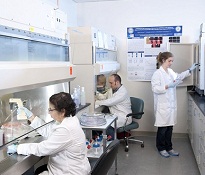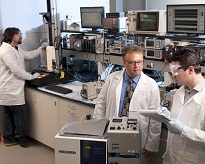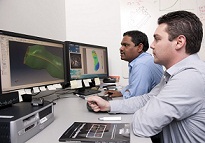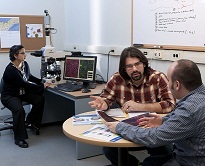Our Vascular Bioengineering Laboratory (VBL) has the capability and equipment to conduct research in the following areas:
 This is a 435 ft2 dedicated room equipped to perform cell and tissue culture in a BSL-II environment, maintain in culture and/or stimulate (with biomechanical or biochemical stimuli) cells and tissues in 2D and 3D environments.
This is a 435 ft2 dedicated room equipped to perform cell and tissue culture in a BSL-II environment, maintain in culture and/or stimulate (with biomechanical or biochemical stimuli) cells and tissues in 2D and 3D environments.
 This is a 1350 ft2 laboratory equipped to perform biomechanical testing (tensile testing, peel testing, indentation testing, and perfusion of intact tubular segments). Here we can also study gene and protein expression from fibrous vascular tissues and cells using RT-PCR, PCR, Western blotting, dot blotting, and Northern blotting; use ELISA and/or other assays using fluorescence, luminescence and colorimetric techniques; cryosection tissue and grafts for histological analysis; stain tissue/grafts/cells for histological, immunofluorescence, or immunocytochemical imaging; and rigorously determine mechanical properties of cylindrically-shaped tissues as small as a mouse aorta and as large as a human aorta. We have a DI/RO water purification system and dewars to cryogenically preserve cells and tissues indefinitely.
This is a 1350 ft2 laboratory equipped to perform biomechanical testing (tensile testing, peel testing, indentation testing, and perfusion of intact tubular segments). Here we can also study gene and protein expression from fibrous vascular tissues and cells using RT-PCR, PCR, Western blotting, dot blotting, and Northern blotting; use ELISA and/or other assays using fluorescence, luminescence and colorimetric techniques; cryosection tissue and grafts for histological analysis; stain tissue/grafts/cells for histological, immunofluorescence, or immunocytochemical imaging; and rigorously determine mechanical properties of cylindrically-shaped tissues as small as a mouse aorta and as large as a human aorta. We have a DI/RO water purification system and dewars to cryogenically preserve cells and tissues indefinitely.
 This is a 135 ft2 room equipped with several high-end workstations for 3D reconstruction, finite element analysis, computational fluid dynamics analysis and fluid-structure interaction analysis.
This is a 135 ft2 room equipped with several high-end workstations for 3D reconstruction, finite element analysis, computational fluid dynamics analysis and fluid-structure interaction analysis.
 This is a 150 ft2 space used exclusively for microscopy, and is equipped to study tissues, cells, and thin sections using brightfield and fluorescence microscopy at all standard magnifications within the infrared region of the spectrum, for many common histological practices including immunohistochemistry and immunocytochemistry.
This is a 150 ft2 space used exclusively for microscopy, and is equipped to study tissues, cells, and thin sections using brightfield and fluorescence microscopy at all standard magnifications within the infrared region of the spectrum, for many common histological practices including immunohistochemistry and immunocytochemistry.